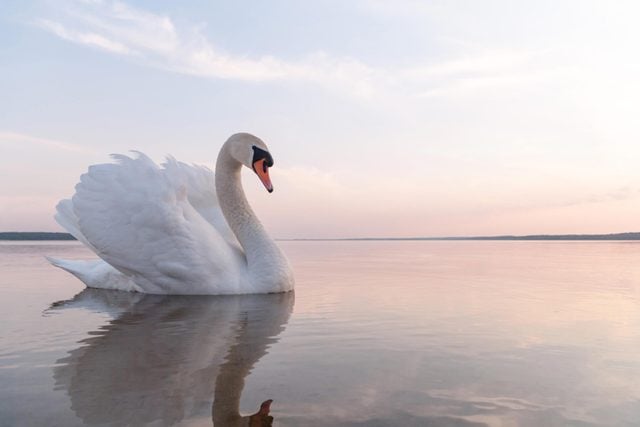Here’s the Strange History Behind Why Swans Are a Symbol of English Royalty
Updated: Feb. 07, 2023
Swans deserve the royal treatment too!

Prince George and Princess Charlotte aren’t the only ones who get to reap the rewards of the royal treatment in the United Kingdom—swans do too. Every year towards the end of July, the Queen’s Royal Swan Marker and her Swan Uppers grab their red or blue blazers with royal insignia, hop in their wooden skiffs and row up the 79-mile long River Thames with the help of the Worshipful Companies of Dyers and Vintners, two of the richest and most powerful trade guilds in London, to count swans in an effort to help protect the mute swan population. The extravagant five-day event is called Swan Upping, an old tradition deep-seated in a former era when the crown tried to exert its authority over who could and couldn’t own swans.
Back in the Medieval Ages, swans were seen as a luxury good that only the wealthiest with a purse full of shillings could afford. During Edward III’s reign, swans were priced at four to five shillings apiece, which was about three to four times the price of a pheasant and nearly 10 times more than a goose. (Check out how much the British Royal Family is actually worth!) In fact, Henry III issued a number of mandates in 1249 for swans to be used at royal festivals. For every feast he hosted, he demanded that the sheriffs in that county deliver him the exact amount of swans he requested for the occasion and nothing less. The largest swan requisition totaled in at 125 swans for the royal court’s Christmas feast at York in 1251.
In fact, the earliest record of swan-keeping on the Thames occurred in 1230 when Henry III issued a mandate which stated that a brood of swans should be divided amongst the owners of the parent birds instead of the owner of the dam keeping them all for himself. A custom that was typically reserved for domesticated animals.
By 1483, several Acts of Parliament started restricting the ownership of Thames swans to protect the exclusivity of this fair commodity. One act designated swan ownership to people with freehold estate of at least five marks a year. In other words, commoners were prohibited from owning the regal bird.
To declare proper ownership of the birds, people had to purchase a swan mark at a pricey six shillings to nick into the beak of their swan. Any swans without a mark were automatically property of the crown. One historian said there were as many as 630 different swan marks circulating between 1450 and 1600. And the penalty for defacing, counterfeiting, or altering a swan mark was pretty tough – one year in prison. But these strict, classist rules didn’t stop people from swan stealing or breaking the law and owning a forbidden majestic swan anyway. (These are the 14 etiquette rules every royal must follow. Period.)
Towards the end of the 18th century, swan rights on the Thames were limited to only three groups: the English Crown, and the Worshipful Companies of Dyers and Vintners. The king’s swans had two diamond-shaped marks on the bill, the Dyers company made one nick on the left side of the upper mandible, and the Vintners company nicked two marks on either side of the bill, while all other unmarked swans still remain property of the crown to this day. The act of catching young swans in the river to mark them was the early beginnings of the modern day swan upping.
If you observe swan upping in present-day England, you’ll still hear the traditional cry of “All up!” when someone spots a mother swan and her babies gliding gracefully across the water. But the centuries-old English custom has evolved greatly since its start. The uppers for the Crown and Dyers and Vintners companies no longer grab swans to exert their supreme status or consume them. Now their methods are much more humble—to protect and conserve the pristine white birds. (This is the incredibly sweet reason why Prince William broke royal protocol.)
Mute swans are protected under the 1981 Wildlife and Countryside Act, which makes it illegal to keep the birds and kill them. In 1985, the mute swan population dwindled from 1,300 birds in the 1960s to just seven pairs of birds due to river pollution, poisonous lead fishing weights, dog attacks, and the overpopulation of predators.
Once the mute swans are corralled towards the riverbank by the skiffs, the Uppers jump into the water, grab them and restrain their legs so they can weigh, count, and examine the swans for injuries. Rings mark the birds from the Dyers and Vintners companies, while the Crown’s swans remain unmarked. Thanks to the swan upping conservation efforts, the mute swans came in at a count of 134 this year, an increase from 72 in 2016.
Do you aspire to be royal one day? The Royal Family never says these eight words and neither should you.
For more royal rules, check out these regulations that Meghan Markle had to follow when she was pregnant.
[Sources: smithsonian.com, thamesweb.co.uk, britishbirds.co.uk, theswansanctuary.org.uk]